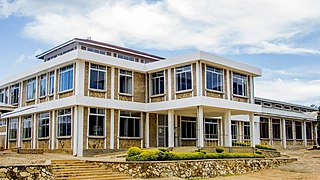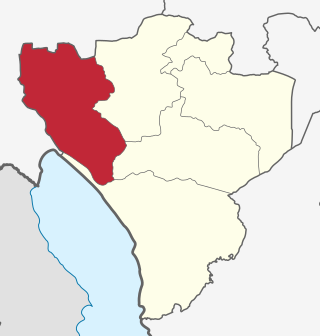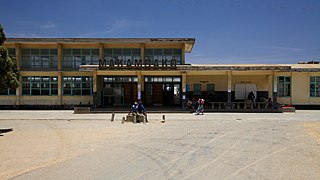
The Tumbuka is a Bantu ethnic group found in Malawi, Zambia and Tanzania. Tumbuka is classified as a part of the Bantu language family, and with origins in a geographic region between the Dwangwa River to the south, the North Rukuru River to the north, Lake Malawi to the east, and the Luangwa River. They are found in the valleys near the rivers, lake as well as the highlands of Nyika Plateau, where they are frequently referred to as Henga although this is strictly speaking the name of a subdivision.

Ludewa District is one of six districts in the Njombe Region in Tanzania, East Africa. Prior to 2012, the district was one of the seven districts of Iringa Region. The town of Ludewa is the administrative seat of the district. A hospital is located in the city. The district is bordered to the north by the Njombe Rural District and Makete District, to the southeast by the Ruvuma Region and to the southwest by the country of Malawi across Lake Nyasa.
The Nyakyusa are a Bantu ethnolinguistic group who live in the fertile mountains of southern Mbeya Region of Tanzania and the Northern Region of Malawi. They speak the Nyakyusa language, a member of the Bantu language family. In 1993 the Nyakyusa population was estimated to number 1,050,000, with 750,000 living in Tanzania. Nyakyusa are marked as highly educated and eager agriculturists. The Nyakyusa are colonising people where success and survival depended on individual effort. Nyakyusa have managed to collect vast wealth from trade and agriculture than any tribe in Tanzania..

Iringa Region is one of Tanzania's 31 administrative regions. The region covers an area of 35,503 km2 (13,708 sq mi). The region is comparable in size to the combined land area of the nation state of Guinea Bissau. Iringa Region is bordered to the east by Morogoro Region and south by Njombe Region. On the west the region is bordered by Mbeya Region. Dodoma Region and Singida Region border Iringa on the north. The regional capital is the city Iringa for which the city is named after. According to the 2022 census, the region has a total population of 1,192,728. Iringa Region is home to Ruaha National Park, Tanzania's second national largest park.

Mbeya Region is one of Tanzania's 31 administrative regions. The region covers an area of 35,954 km2 (13,882 sq mi). The region is comparable in size to the combined land area of the nation state of Guinea Bissau. Mbeya Region is bordered to the east by Singida Region, Iringa Region and Njombe Region. The region is bordered to the south by Malawi and Lake Nyasa. To the north the region borders southern Tabora Region. Lastly, Mbeya is bordered to the west by Songwe Region. The regional capital is the city of Mbeya. According to the 2022 national census, the region had a population of 2,343,754.
The Kipengere Range, also known as the Livingstone Mountains, lies entirely in Njombe Region in southwest Tanzania at the northern end of Lake Nyasa. Near Lake Nyasa they are known as the Kinga Mountains. It is a plateau-like ridge of mountains running southeastwards from the basin of the Great Ruaha River in the north to that of the Ruhuhu River in the south, and forms part of the eastern escarpment of the East African Rift. The range is mostly clad in montane grasslands, renowned for their botanical diversity and displays of flowers, with montane evergreen forests mostly in stream valleys.

Makete District is one of the six districts of Njombe Region of Tanzania. Its administrative seat is the town of Iwawa. It is bordered to the north and west by the Mbeya Region, to the east by the Njombe District and to the south by the Ludewa District. It is divided into six divisions and 17 wards. Makete District was founded in 1979 with the policy of the Ujamaa. Before, this part of Iringa Region belonged to Njombe District. The district is known for growing apples due to the favorable climate.

Tukuyu, known as Neu Langenburg during the German colonial rule, is a hillside town that lies about 36 miles (58 km) south of the city of Mbeya, at an elevation of around 5,000 ft (1,500 m) in the highland Rungwe District of southern Tanzania, East Africa. Tukuyu town has a moderate to cool temperature ranging from 10 °C in May and June to mid 20 °C in around November. The town and surrounding areas are green all year round due to the almost year-round convectional rains resulting from Lake Nyasa(Lake Malawi).Tukuyu town is divided into several wards include; Kawetere, Msasani, Bulyaga and Bagamoyo.
The Sangu, at times called Rori, is an ethnic and group based in the Usangu Plain of Chunya District of Mbeya Region, Tanzania. By 1907, their numbers were thought to be about 30,000. In 1987 their population was estimated to number 75,000.
The Wanji are an ethnic and linguistic group native to Makete District, in the Kipengere Mountains of Njombe Region and also native to Mbeya Region in southern Tanzania. In 2003 the Wanji population was estimated to number 28,000. The wanji language is the composition of nearby languages like Sangu, Kinga, Nyakyusa, Safwa and Bena.

The Matengo are an ethnic and linguistic group based in Mbinga District, Ruvuma Region in southern Tanzania. In 1957, the population estimate was 57,000, while in 2010, the Matengo population was estimated to number 284,000. Their religious affiliation is to Christianity. Their Affinity Bloc is Sub-Saharan African. Their main language is Matengo, which is one of the Bantu languages.
The Magoma are a Bantu ethnolinguistic group based in the Makete District of Njombe Region in southern Tanzania. In 2003, the Magoma population was estimated to number 9,000.
The Kisi are a Bantu ethnolinguistic group from Makete District of Njombe Region, Tanzania, on the northwestern shore of Lake Malawi.
The Kipengere seedeater, also known as the Tanzania seedeater, is a species of finch in the family Fringillidae. It is found only in Tanzania specifically in Mbeya Region and Njombe Region. Its natural habitats are subtropical or tropical moist montane forest and subtropical or tropical high-elevation shrubland. It is threatened by habitat loss.

The following outline is provided as an overview of and topical guide to Tanzania:
Igurusi is an administrative ward in the Mbarali district of the Mbeya Region of Tanzania. In 2022 the Tanzania National Bureau of Statistics report there were more than 28,000 people in the ward, from 24,573 in 2016.
Hehe, also known by its native name Kihehe, is a Bantu language that is spoken by the Hehe people of the Iringa region of Tanzania, lying south of the Great Ruaha River. It was reported to have "Ngoni" features, that is, words of a Zulu-like language introduced when conquered by a Nguni or Zulu-like people in the early 19th century. However, other "Ngoni" speeches seem to have lost most of these distinctive features over the past 150-odd years, the language more resembling those of the neighbouring peoples. In the 1970s, it was estimated that 190,000 people spoke Hehe. There has been some Bible translation. Hehe may be mutually intelligible with Bena.

Makambako is a medium-sized town and district in the Njombe Region of the Tanzanian Southern Highlands, located roughly 40 miles north of Njombe city by road. It is located at junction of the A104 and B4 roads between Njombe, Iringa, and Mbeya. Its population according to the 2002 Tanzanian census was 51,049.

Njombe Region is one of Tanzania's 31 administrative regions which covers a land area of 21,347 km2 (8,242 sq mi). The region is comparable in size to the combined land area of the nation state of El Salvador. Njombe Region is bordered to the north by the Iringa Region and Mbeya Region, to the east by Morogoro Region, to the south by the Ruvuma Region and to the west by Lake Nyasa. The regional capital is the municipality of Njombe. According to the 2012 national census, the region had a population of 702,097.
The name Karonga War is given to a number of armed clashes that took place between mid-1887 and mid-1889 near Karonga at the northern end of Lake Malawi in what is now Malawi between a Scottish trading concern called the African Lakes Company Limited and elements of the Ngonde people on one side and Swahili traders and their Henga allies on the other. In the 19th century, it was referred to as the “Arab War”, despite few actual Arabs being involved. Although these conflicts predate formal endorsement of a British Central Africa Protectorate west of Lake Malawi in 1891, European involvement, both by the African Lakes Company and by Germans attempting to prevent Swahili slave trading around Lake Tanganyika in German East Africa, had upset the previous balance between the Ngonde and their neighbours and created the conditions for this conflict. It was between the Tumbuka and Nyakyusa-Ngonde ethnic groups.










